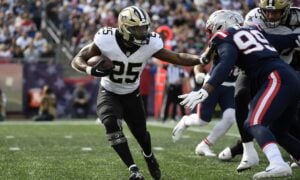Player Lifetime Value: The Process

“Potential has a shelf life.” – Margaret Atwood
The historic 2014 rookie class has caused an upswell in dynasty owners chasing potential in the form of rookies and young players yet to prove themselves. Much of this has been to the behest of veterans in their prime and short-term solutions who could lead teams to a dynasty championship. As Eric Burtzlaff demonstrated in his fantastic series on dynasty profitability, there is a price to be paid for delaying title aspiration in the hopes of building a long-term contender.
All this is not to say that you should shun young players, but rather, it is understanding the impact of waiting a year (or more in the case of players like Christine Michael) to payback your initial investment. A simple example would be the following:
You have a choice to be given a $1,000 today or $1,050 a year from now. Do you take the higher dollar amount or believe that you can use that $1,000 to profit at a greater rate than 5% in one year ($50)?
My aim in this two part article is to share my evaluation of players when accounting for the time value of fantasy points. This is not meant to be a new ranking system, but instead, evoke another tool for your dynasty utility belt. In the first part, I will lay out the process and considerations made when conducting this analysis. In part two, we will look at some unique scenarios and see what conclusions we can draw.
The Process
How do we figure out lifetime fantasy points?
[am4show have=’g1;’ guest_error=’sub_message’ user_error=’sub_message’ ]
Prognostication is an art to which we can attempt applying science. For me, it begins with the great work done at 4for4. With time value calculations, the most recent values have the highest influence on outcomes so it makes sense to use the best in the business at yearly predictions for my 2015 baseline. If you want to see those inputs, I recommend subscribing to 4for4 immediately.
From there, I combined their projections with past performance, age/experience and other factors to apply to a positional “aging process” to come up with annual estimates of future years. I wish I was confident enough to believe this will be accurate, but that wouldn’t be fair to you. Instead, I created a way to test scoring scenarios to help answer questions if I don’t trust the output on a specific player (something we will use in part two).
What do we use for a discount rate?
This might be the hardest part of the evaluation of players when trying to utilize a time value approach. Typically, a discount rate is the interest rate you believe an investment can accrue over a time period, which you use to translate future earnings into today’s dollars. That, for fantasy football, however, is subjective based on the owner and their expectations. Instead, I will utilize two different rates to show a more conservative approach and one that is more aggressive, each with a rationale of sorts.
20% – This is the conservative discount rate I will use in part two. This percentage is based off a few different factors. First, it is a reasonable rate to account for a longer career arc, something pivotal as we play dynasty, not redraft. Also, it reflects an annual return that would be anticipated from a strong investment.
60% – I know, it is a big number but hear me out. I wanted to analyze trades of draft picks, specifically those where picks in the current year were traded for a higher draft pick (usually a round upgrade) for the next year. These types of trades were the best way to isolate the exchange of value for time.
Zach Bahner’s work over the last three years looking at rookie pick value was extremely beneficial in analyzing those trades and determining what the tradeoff in value was in exchange for the year difference in draft choices. Ultimately, these trades saw a 50-70% increase in value (e.g. 2016 1st) in order to utilize the asset sooner (e.g. 2015 2nd). Therefore, I decided to split the difference and use this as my aggressive scenario. It will severely deflate the values of future years but provides a market-established discount rate to use and compare against.
What are the risks of this analysis?
One of the biggest assumptions here is that situation remains relatively constant – that’s based on using historical data and 2015 projections in the calculation. Players switch teams, teammates retire and injuries occur quite frequently. As dynasty owners, we all try and plan for these scenarios but they are impossible to predict.
Another risk involves the inclusion of young players, especially rookies who have less information to utilize. Some of those concerns are alleviated by the 2015 projections but not all young players have prominent roles from the beginning. That is why we have the ability to adjust outcomes and create scenarios, something we will play with a little in part two.
Are you salivating yet? Come back tomorrow as we dive into the whole study!
[/am4show]
- Bowl Game Previews: CFB Playoff Semifinals - December 28, 2018
- The Narrative Fallacy and How it Compels Us - May 13, 2017
- 2017 NFL Draft – College Wide Receiver AIR - April 27, 2017

































































